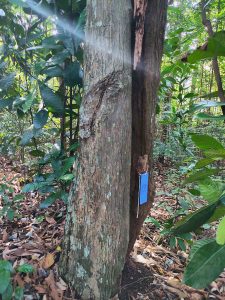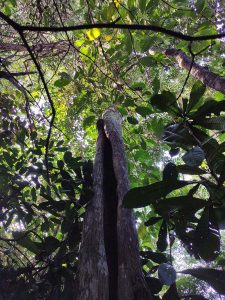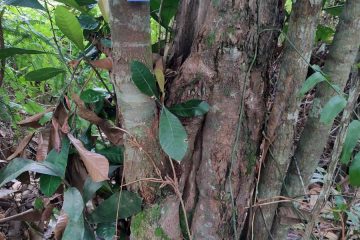7
Kulim - Scorodocarpus borneensis (Baill.) Becc. - Olacaceae
Other names:
Bawang Hutan, Forest Onion, Garlic Nut, Nutwood Garlic, Sindu, Wood Garlic, Woodland Onion and Kulim[1].
General information:
Trees are found on slopes and hillsides in primary and secondary mixed dipterocarp forests. Commonly found in Peninsular Thailand, Peninsular Malaysia, Sumatra, and throughout the island of Borneo[2].
Distinguish botanical characteristics:
The plant is tall and may reach height of 25 m with a trunk diameter of 60 cm. The leaves are broadly elliptic with 10-20 cm long and 40-10 cm wide. The flowers of the plant are pinkish-white and small with size of 1.3 cm long. The fruit of the plant consists of hard outer nutshell and pulp similar to walnut as it ripe and fall from the tree. However, it has unique smell which not found in walnut[2]
Uses:
The leaves can be eaten as vegetables and the fruits can be cooked and used a seasoning to food. The wood usually used for indoor construction and boat building[2]
Major/bioactive phytochemicals:
Flavonoid glycosides: lucenin-2, vicenin-2 and isoschaftoside tricin 7-0-glucoside and isorhamnetin 3-0-robinobioside[3]
Sulphur-containing amino acids: (Rs)-3-[(methylthio) methyl sulfinyl]-L-alanine and S-[(methylthio) methyl]-L-cysteine [4] 97% methyl methylthiomethyl disulfide, and 49% bis(methylthiomethyl) disulphide-characteristics odour of the fruit of S. borneensis[2].
References:
[1] https://www.mybis.gov.my/sp/1556
[2] Kubotaet al. (1994).. Bioscience, Biotechnology, And Biochemistry, 58: 644–646. http://doi.Org/10.1271/Bbb.58.644
[3] Fumiko Abe and Tatsuo Yamauchi. (1993). Phytochemistry.33(6), 1499–1501
[4] Haeyoung et al. (1998). Phytochemistrv, 48(5):787–790.
SK & SZMS 2022


